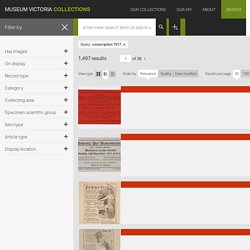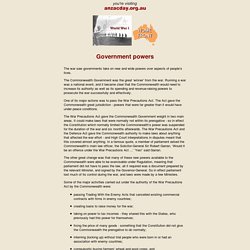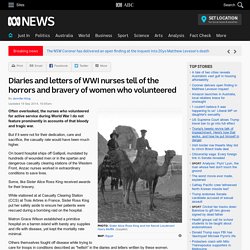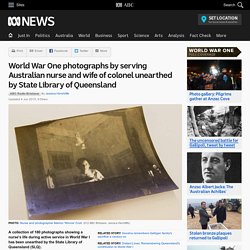

Search Museum Victoria's collections. Skip to main content item HT 38691 Newspaper Cutting - The Herald, 'Special Referendum Edition', 10.15 pm, 20 Dec 1917 Public Life & Institutions, Home & Community Front page from The Herald, 'Special Referendum Edition', 10.15 pm, 20 December 1917.

The edition announces returns for the World War I conscription referendum at Yes 95,118; No 111,858, ... item HT 504 Badge - 'For God, King, Empire', Victorian Protestant Federation, World War I, circa 1917 Home & Community, Public Life & Institutions Victorian Protestant Federation badge, 'For God, King, Empire', made circa 1917. Item ST 36610.2 Diary - Driver Claude Ewart, Egypt & France, Vol 2, World War I, 13 Mar 1916 - Aug 1917. William Hughes and the 1916 Conscription Badge - English and Media Literacy, Australian Biography. William Hughes and the 1916 Conscription Badge is an episode from the series The Prime Ministers’ National Treasures, produced in 2007.

The Prime Ministers’ National TreasuresAward winning cartoonist and yarn spinner, Warren Brown, reveals the emotional lives of Australian Prime Ministers through 10 objects they used every day or even adored – from Robert Menzies’ home movie camera, to Joseph Lyons’ love letters, Harold Holt’s briefcase and Ben Chifley’s pipe. These treasures reveal the nation’s leaders, as you have never seen them before. The Prime Ministers’ National Treasures is a Film Australia National Interest Program produced in association with Old Parliament House and the Australian Broadcasting Corporation. National Statements of Learning for EnglishYear 9 Writing Students write extended or sustained texts that entertain, move, inform and persuade in print and electronic mediums. This is an extract only. Background Information top The referendum was very narrowly defeated. The Home Front - history(9) - ABC Splash - Museum of Australian Democracy at Old Parliament House.
Australia - The Enemy at Home - Goethe-Institut. The Australian Home Front during World War 1 - Government powers. Government powers The war saw governments take on new and wide powers over aspects of people’s lives.

World War One Research and Empathy Task. Nurses - Australians in World War 1 - Research Guides at State Library of Victoria. There were few active roles open to Australian women during World War I.

A handful of Australian women worked as doctors during World War I. Click on Women's war work for books on this subject. Women in Australia helped the war effort through charitable work such as fund-raising, knitting or sending food to the troops. When war broke out, some Australian women travelled overseas at their own expense to help the wounded, while others already overseas enlisted as nurses in British hospitals or in the British army’s nursing service. Others worked as drivers overseas.
Nursing provided a major opportunity for Australian women to participate actively in the war. Australian nurses proved to be energetic, hardworking and resilient in very difficult circumstances. Books dealing with Australian nurses include the following. Diaries and letters of WWI nurses tell of the horrors and bravery of women who volunteered. Updated Often overlooked, the nurses who volunteered for active service during World War I do not feature prominently in accounts of that bloody and tragic war.

But if it were not for their dedication, care and sacrifice, the casualty rate would have been much higher. On board hospital ships off Gallipoli, inundated by hundreds of wounded men or in the spartan and dangerous casualty clearing stations of the Western Front, Anzac nurses worked in extraordinary conditions to save lives. Some, like Sister Alice Ross King received awards for their bravery. While stationed at at Casualty Clearing Station (CCS) at Trois Arbres in France, Sister Ross King put her safety aside to ensure her patients were rescued during a bombing raid on the hospital.
Matron Grace Wilson established a primitive hospital on a barren island with barely any supplies and rife with disease, yet kept the mortality rate minimal. Australian Women in War - Home. World War One photographs by serving Australian nurse and wife of colonel unearthed by State Library of Queensland. Updated A collection of 180 photographs showing a nurse's life during active service in World War I has been unearthed by the State Library of Queensland (SLQ).

The photographer and nurse Marion Winifred Croll — known as 'Winnie' — took many snaps during her service and leave throughout Egypt in 1915. The library recently acquired the collection after recognising one of the photographs up for sale in an online auction. State Library curator Robyn Hamilton said that one of the photos in the auction was similar to a photo of Ms Croll currently being used in one of their exhibitions.
"The auction house couldn't identify who the woman was so we had a look at the photos and the penny dropped ... we knew who she was," she said. "We discovered that she was the wife of a doctor whose collection we have here at the John Oxley Collection; not only that, he is one of the 25 Queenslanders featured in our current Distant Lines exhibition. "It completed a wonderful circle. A global guide to the first world war - interactive documentary. Australians in World War 1 - Research Guides at State Library of Victoria. This is a guide to finding records on Australian service personnel and their war activities.

This includes medical personnel such as doctors and nurses. Non-combatants such as journalists and photographers also enlisted in the army, so army records are relevant to them too. This guide explains how to access these records online and in print sources.